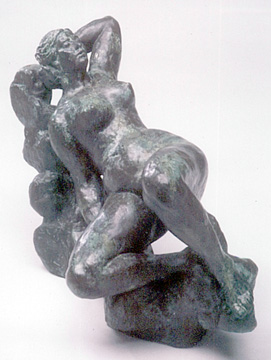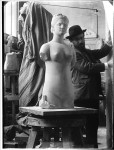
Emile Antoine Bourdelle
French, 1825-1905
The Cloud, 1905-1908 ca.
bronze in the lost wax method
32 x 29 in.
Bequest of Margaret Mallory
1998.50.17

A young Bourdelle in the studio
RESEARCH PAPER
Bourdelle's Artistic Influences and Legacy
Bourdelle was born in the village of Montauban, the birthplace of Ingres. His father was a furniture maker, his uncle a stone mason. As a child Bourdelle herded goats, amusing himself by carving wood and modeling clay figures. At thirteen he left school to work as an ornamental carver in his father’s business. These early experiences, as well as the local, stony countryside rich in Romanesque ruins, influenced his later work as a sculptor. At fifteen Bourdelle entered the Toulouse School of Fine Arts. Ten years later he studied with Falguiere at the Ecole des Beaux-Arts in Paris, leaving there after two years to study with Dalou.
In 1893 Bourdelle met Rodin, resulting in a fifteen year association which included working as one of Rodin’s chief marble carvers and advisors and establishing with him a free school for sculptors. Rodin spoke of Bourdelle as "a beacon of the future." An influential teacher until the end of his life, Bourdelle’s notable students included Richier, Giacometti, and Matisse. Bourdelle’s work is "divided between two tendencies . . . so different as to appear contradictory." The first, lasting into the first decade of the 1900s, strongly reflected the expressive influence of Rodin. His later work, presaged in The Head of Apollo (SBMA 1993.1.28) evolved away from Rodin into a style of constructing in planes, reminiscent of 12th century stone cutters and anticipating cubist sculptors such as Picasso and Lipschitz. His finest work reflects archaic Greek and Gothic influences. Bourdelle is today best remembered for his monumental sculptures such as the equestrian bronze Alvear (1925). In 1949 the Muse Bourdelle was established in Montparnasse to celebrate his life and work.
The Cloud
Physicality
Although of an "intimate" size, the figure has immense heft, solidity, and a sense of fleshy materiality. Its active surface, exaggeratedly rugged and tactile, reminds of its earthy birth in clay. The body and head cover the hands, pinning them firmly to the base. The head is slightly small, increasing the body’s physicality. The overall density is lightened by the voids created between the legs and the base and between the arms and the body.
Pose and Expression
Positioned precariously on its base, the female nude is artlessly open to view, hiding nothing. The lower body twists out diagonally into the viewer’s space in innocent yet inviting abandon, the torsion creating an anatomically incorrect misalignment of navel and sternum. The back is beautifully modeled with a deep spinal cleft. The face with its closed eyes and barely parted lips expresses dreamy repose as if the figure itself is a part of nature (a cloud) or under a spell of the clouds themselves. The figure’s nudity and lack of attributes allow a timeless interpretation.
Hair
The hair, in contrast to the figure’s unrestrained pose, is plaited and wound tightly around the head. This style closely resembles the way Bourdelle’s wife wore her hair as seen in his bronze Sculptress Resting, 1905-08. This hairstyle also appears in other female sculptures Bourdelle did at the time.
Title
Whether Bourdelle meant the figure to represent a cloud, a woman resting on a cloud, or simply a woman engaged in watching clouds is unclear. The contrast, however, between the earthiness of the form and its ethereal title suggests "unending conflict between the spirit and matter" and Bourdelle’s belief in "that half-divine presence in man."
Debt to Rodin "The great sculptor’s influence . . . is especially noticeable in The Cloud (1905)."
Visible hand of the artist
The marks of the sculpting process on the figure’s surface are clearly derivative of Rodin who was the first to exhibit sculptures deliberately allowing the viewer to see the process by which sculpture is made. As with Rodin, these marks enhance the immediacy and expression of the object. The example of the navel being out of alignment with the sternum is often seen in Rodin’s work—giving the torso a larger-than-life, exaggerated torsion.
Psychological realism
Rather than an object to be viewed for its formal, exterior image according to academic canon, The Cloud, through its highly expressive surface and ambiguous pose, exudes an emotional, psychological energy charged from within. This innerly reflexive/outwardly emanating aspect is characteristic of Rodin’s best work.
Dialogue with the viewer:
Rodin was the first to present a figure totally outside any familiar context as signified by attributes, precise title, or recognizable "meaning." The Cloud, also without these devices, forces the viewer to enter into a dialogue with the artist in a search for understanding. Thus, the viewer is free to form his/her own interpretations and by so doing becomes part of the artistic process itself.
Conclusion
The Cloud is a fine, representative example of Bourdelle’s early work. Of particular interest is its evidence of Rodin’s influence and its similarities and differences to other sculptures in the gallery made in the same period.
Prepared for the Santa Barbara Museum of Art Docent Council by Mary Eckhart—March 2001.
POSTSCRIPT
Dating:
Although the museum’s object is not dated, several sources refer to it as dating from 1905-1908. (Rodin-influenced early period)
Patina: "Pigmented patination" with "several white areas of what looks to be fills from losses in the original casting." The surface is waxed.
Surface marks: Marks from the original clay modeling and bronze casting processes such as evidences of pressed-on lumps of clay, tool striations, cross hatching from dampening cloths, and casting seams. The base is more roughly modeled than the figure. There is a mark on base: Possibly a foundry mark
